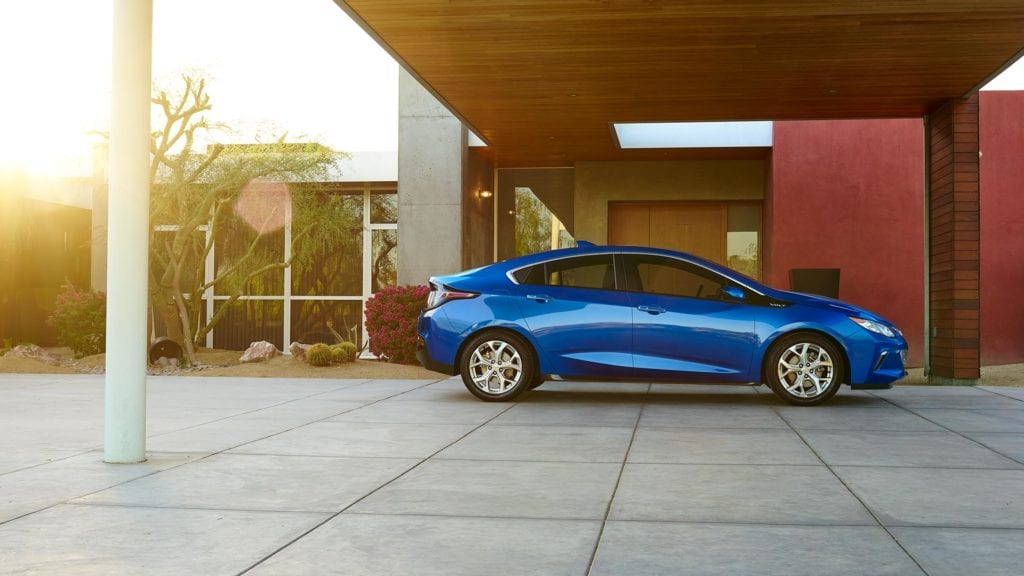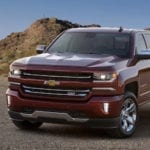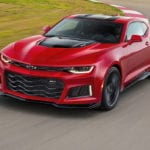The second generation 2017 Volt for sale is enjoying a strong and successful start on the market. Not only is Chevy selling more of the gen two as it did the gen one around the same time last year, but the Volt is even beating the Nissan Leaf in terms of models sold. If it’s doing so well though, you might be wondering why you aren’t seeing that many Volts on the road — and I have the answer. Also, what is making this one so successful when compared to the first generation? It seems the new redesign is paying off, the catalyst for its success. So, we’ll also take a look at why that redesign has been such a huge home run.
Honestly, the Volt looks like a whole new car. It’s more athletic, aggressive, handsome, sleek, and sculpted compared to the first generation. That’s pretty unique when it comes to electric cars because not all of them look like a sporty sedan.
The Numbers

Obviously, the consumers love it. Compared to April of 2015, the second generation Volt has sold over twice as many as the first generation. Specifically, the Volt has sold over 1,983 as of April 2016, compared to 905 in April 2015.
Along with beating its own personal best, the fresh look and enhanced performance allowed the Volt to quickly outpace the Nissan Leaf, which is a big name in the EV market. The Volt has sold 94,720 units, while the Leaf has sold 93,309. Just looking at the numbers, it’s clear that Chevy would have had a tough time had they not revamped the Volt for its second generation. After all, when consumers heard there was a second gen Volt with a new look on the horizon, many of them decided to hold out for it, which explains the boom in sales at the start of this year when it was released.
This can go two ways from here, meaning either a bad or good future for the Volt. The first is that everyone who wanted a Volt has already bought it, and the sales have already hit their plateau for the year. Alternatively, this massive boom could promote the Volt even faster, and the great reputation it’s garnered since its release will help spur the sales onward and upwards for the rest of the year. Given that electric cars are still relatively new to the market, it’s hard to predict which way the Volt’s future is going to go.
Why Aren’t we Seeing More of Them?
With the newfound success of the 2017 Chevy Volt, it’s only natural that if you have access to the internet and follow news updates on cars, you’ve already heard of it. But, what about actually seeing it on the roads? Why aren’t we seeing more new Volts if they are such a huge hit, and the internet continually broadcasts its success? I don’t know about you, but I haven’t seen one of these on the road yet. Granted, I also live and work in a more rural setting, but my house is only about an hour away from two major cities. So by now, I would have thought that I’d have seen at least one during highway travel. They are being offered nationwide now, so it’s not like they are only available in specific states.
It’s a two part problem, really. But before I get into it I want to say that this isn’t intended to bash Chevy or their dealerships. I’m just simply trying to explain why we aren’t seeing more Volts on the roads.
The first problem is Chevy isn’t really doing anything to promote the car. For whatever reason, the brand just isn’t marketing it as heavily as its other vehicles. Secondly, some Chevy dealers don’t even know what they have sitting on their lots, or that it’s an electric vehicle. Don’t believe me? There are plenty of horror stories on the web about people asking about the 2017 Volt, and salesman on the floor going, “Wait, that’s an electric vehicle?” Or, they know what it is, but don’t know enough about it to explain it to the consumer. Therefore, any interest the consumer expresses in the Volt, including possibly wanting to test drive it, is shut down because they don’t feel comfortable having someone who is just as clueless about it try and walk them through it.
Chances are, this is the primary reason we aren’t seeing more Volts on the road. And that’s sad because this is the time to be promoting and selling the vehicle. Keeping the hype going and sales rolling for as long as possible will keep distancing the gap between Chevy and other competitors like the Nissan Leaf.
It’s not anyone’s fault, really. It’s a new second-generation electric car, and most-likely the salesmen have been dealing with gasoline-powered cars their entire lives. Therefore, Chevy needs to make it a point to educate its salesmen about the new Volt.
It’s Just Awesome
Those who know about electric cars know that the new Volt is just a downright awesome car — which is the sole reason it’s doing so well.
The biggest praise the Volt receives from most who have driven one is that it looks, drives, and feels like a standard sedan. But, it has the efficiency and environmentally-friendly perks of an electric car. Its ability to drive up to 53-miles on a single battery charge saves loads of gas on your daily commute. Knowing that you have 367 miles left on a full tank of gas when the battery runs out on that long road-trip provides consumers with the assurance they are looking for. This ability to be an EV that can do both gives you the confidence to go as far as you want, and fill up the way you would any other car on a long road trip. Plus, it has the power and handling of a regular sedan, which means it has plenty of pick-up for merging on the highway and has more attitude than some of the other EVs on the market.
On top of all this, it has plenty of advanced safety and entertainment technology features in it, meaning its an EV that doesn’t compromise fun and safety in order to maintain efficiency and power.
Overall, it really is just an awesome car, and I’ve seen nothing but glowing reviews about it. The only downside? The trunk is a little too big and cuts into the rear passenger room. That’s the only negative comment I’ve seen mentioned about the 2017 Volt, which means Chevy really nailed it with this redesign.






